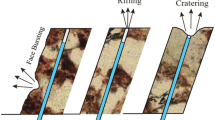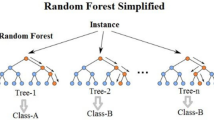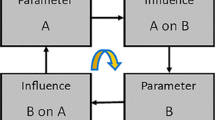Abstract
Rock fragmentation and movement are two important outcomes of the blasting process in open pit mines. They are influenced by blasting design parameters, as well as by the physical and geomechanical characteristics of the rock mass. This paper presents the analysis results of multi-year blasting data from an open pit mine in Canada and proposes a predictive model for the blast-induced outcomes that incorporates both rock mass properties and blasting parameters. The analysis employed the decision tree (DT) and random forest (RF) models to determine influential parameters, confirming that the blast-induced fragmentation and movement are influenced by rock mass characteristics (i.e. intact rock strength and rock quality designation, RQD), as well as by blasting design parameters. The decision tree model facilitates the visualization of geomechanical and blasting design parameters influencing the blast-induced outcomes. The robust random forest model provides prediction of blast-induced outcomes. The decision tree and random forest models make it possible to determine blasting design parameters that could be modified to achieve better blast-induced outcomes based on the rock mass conditions at the mine site.











Similar content being viewed by others
References
Amini H, Gholami R, Monjezi M, Torabi SR, Zadhesh J (2012) Evaluation of flyrock phenomenon due to blasting operation by support vector machine. Neural Comput Applic 21:2077–2085. https://doi.org/10.1007/s00521-011-0631-5
Ash RL (1963) The mechanics of rock breakage, parts I IV; pit and quarry, Vol. V 2:98–100
Bamford T, Esmaeili K, Schoellig AP (2017) A real-time analysis of post-blast rock fragmentation using UAV technology. Int J Min Reclam Environ 31(6):439–456. https://doi.org/10.1080/17480930.2017.1339170
BMT Blast Movement Monitoring (2018) https://blastmovement.com/blast-monitoring
Breiman L (2001) Random forests. Mach Learn 45(1):5–32
Breiman L, Cutler A (2004) Random forests. https://www.stat.berkeley.edu/~breiman/RandomForests/
Broch E, Franklin J (1972) The point-load strength test. Int J Rock Mech Min Sci 9(6):669–698
Brunton I, Thornton D, Hodson R, Sprott D (2003) Impact of blast fragmentation on hydraulic excavator dig time. In: Proceedings of the 5th Large Open Pit Mining Conference, Kalgoorlie, Australia, p 39–48
Carmona HA, Wittel FK, Kun F (2014) From fracture to fragmentation: discrete element modeling. Eur Phys J Spec Top 223:2369–2382. https://doi.org/10.1140/epjst/e2014-02270-3
Cunningham CVB (2005) The Kuz-Ram fragmentation model-20 years on. In: Proccedings of Brighton conference. Sussex, England, p 201–210
Deere D, Deere DW (1988) The rock quality designation (RQD) index in practice. In: Rock Classification System for Engineering Purposes, Philadelphia, USA, p 91–101
Domingo J, Leite F, Mirada V, Carrasco I (2015) Dilution, ore grade and blast movement calculation model. In: Proceedings of 11th International Symposium on Rock Fragmentation by Blasting, FRAGBLAST 11. Sydney, Australia, p 71–78
Dyno Nobel (2010) Blasting and explosives quick reference guide
Ebrahimi E, Monjezi M, Khalesi MR, Jahed Armaghani D (2016) Prediction and optimization of back-break and rock fragmentation using an artificial neural netwrok and a bee colony algorithm. Bull Eng Geol Environ. https://doi.org/10.1007/s10064-015-0720-2
Eloranta JW (1997) The efficiency of blasting versus crushing and grinding. In: Proceeding of the 23rd conference on Explosives and Blasting Techniques, Las Vegas, USA
Faradonbeh RS, Monjezi M, Jahed Armaghani D (2016) Genetic programing and non-linear multiple regression techniques to predict backbreak in blasting operation. Eng Comput 32:123–133. https://doi.org/10.1007/s00366-015-0404-3
Ghasemi E, Sari M, Ataei M (2012) Development of an empirical model for predicting the effects of controllable blasting parameters on flyrock distance in surface mines. Int J Rock Mech Min Sci 55:163–170. https://doi.org/10.1016/j.ijrmms.2012.03.011
Golder Associates Ltd. (2008) Detour Lake Project: preliminary pit slope design. Report
H2O.ai (2018) Overview — H2O 3.20.0.4 documentation Available online: http://docs.h2o.ai/h2o/latest-stable/h2o-docs/index.html
Hajihassani M, Jahed Armaghani D, Marto A, Tonnizam Mohamad E (2014) Ground vibration prediction in quarry blasting through an artificial neural network optimized by imperialist competitive algorithm. Bull Eng Geol Environ. https://doi.org/10.1007/s10064-014-0657-x
Hudaverdi T (2012) Application of multivariate analysis for prediction of blast-induced ground vibrations. Soil Dyn Earthq Eng 43:300–308. https://doi.org/10.1016/j.soildyn.2012.08.002
Hunt W, Thornton D (2014) Modeling vs. Monitoring Blast Movement: The Cost of Variation. In: Proceedings of 40th Annual Conf. on Explosive and Blasting Technique, ISEE; 2014 Denver, USA
Isaaks E, Barr R, Handayani O (2014) Modelling blast movement for grade control. In: Proceedings of Ninth International Mining Geology Conference; The Australasian Institute of Mining and Metallurgy: Melbourne, Australia, p 433–440
Kanchibotla S, Valery W, Morrell S (1999) Modelling fines in blast fragmentation and its impact on crushing and grinding. In: Proceedings of the Explo 99-A conference on rock breaking. Kalgoorlie, Australia, p 137–144
Khandelwal M, Armaghani DJ, Faradonbeh RS, Yellishetty M, Majid MZA, Monjezi M (2017) Classification and regression tree technique in estimating peak particle velocity caused by blasting. Eng Comput 33:45–53. https://doi.org/10.1007/s00366-016-0455-0
Kuznetsov VM (1973) The mean diameter of the fragments formed by blasting rock. J Min Sci 9(2):144–148
Lopez Jimeno C, Lopez Jimeno E, Carcedo FJA (1995) Drilling and blasting of rocks. A.A. Balkema, Rotterdam/Brookfield
Mosher J (2011) Crushing, milling, and grinding. SME Min Eng Handbook 2:1461–1480
Onederra I, Furtney J, Sellers E, Iverson S (2013) Modelling blast induced damage from a fully coupled explosive charge. Int J Rock Mech Min Sci 58:73–84. https://doi.org/10.1016/j.ijrmms.2012.10.004
Ouchterlony F (2005) The Swebrec© function: linking fragmentation by blasting and crushing. Min Technol 114:29–44. https://doi.org/10.1179/037178405X44539
Rokach L, Maimon O (2010) Data mining and knowledge discovery handbook-chapter 9: decision trees. Springer. p 165–192
Sanchidrián JA, Ouchterlony F (2017) A distribution-free description of fragmentation by blasting based on dimensional analysis. Rock Mech Rock Eng 50:781–806. https://doi.org/10.1007/s00603-016-1131-9
Sanchidrian JA, Segarra P, Ouchterlony F, Lopez LM (2009) On the accuracy of fragment size measurement by image analysis in combination with some distribution functions. Rock Mech Rock Eng 42:95–116
Scott A, Onederra I (2015) Characterising rock mass properties for fragmentation modelling. In: Proceedings of 11th International Symposium on Rock Fragmentation by Blasting, FRAGBLAST 11, Sydney, Australia, p 149–160
Silve A, Martins P, Silva E, Fonseca A, Ferrari A, Cunha E, Silva V, Matthew V, Vilela D (2015) Fragmentation optimisation – adopting mine to mill for reducing costs and increasing productivity. In: Proceedings of 11th International Symposium on Rock Fragmentation by Blasting; Sydney, Australia, p 363–368
Taylor DL, Firth IR (2003) Utilization of blast movement measurements in grade control. In: Proceedings of the Application of Computers and Operations Research in the Minerals Industries, South African Institute of Mining and Metalurgy
Thornton D (2009) The application of electronic monitors to understand blast movement dynamics and improve blast designs. In: Proceedings of 9th Int. Symposium on Rock Fragmentation by Blasting, FRAGBLAST 9, Granada, Spain, p 287–300
Ulusay R (2014) The ISRM suggested methods for rock characterization, testing and monitoring: 2007–2014. Springer
Wang J, Yin Y, Esmaieli K (2018) Numerical simulation of rock blasting damage based on laboratory scale experiments. J Geophys Eng 15(6). https://doi.org/10.1088/1742-2140/aacf17
Acknowledgments
The authors would like to acknowledge Detour Lake Gold mine and the Natural Science and Engineering Research Council of Canada (NSERC) for their support.
Author information
Authors and Affiliations
Corresponding author
Rights and permissions
About this article
Cite this article
Ohadi, B., Sun, X., Esmaieli, K. et al. Predicting blast-induced outcomes using random forest models of multi-year blasting data from an open pit mine. Bull Eng Geol Environ 79, 329–343 (2020). https://doi.org/10.1007/s10064-019-01566-3
Received:
Accepted:
Published:
Issue Date:
DOI: https://doi.org/10.1007/s10064-019-01566-3




